1.4.2: Fats and Cholesterol
- Last updated
- Save as PDF
- Page ID
- 225658
Learning Objectives
- Describe the digestion of lipids.
- Know the properties and functions of the different types of lipoproteins.
- Know the sources and function of common dietary lipids.
How Does Fat Differ From Lipids? The answer you receive from this question will depend on who you ask, so it is important to have an understanding of lipids and fats from a chemical and nutritional perspective.
To a chemist, lipids consist of triglycerides, fatty acids, phospholipids, waxes, and sterols. These compounds are grouped together because of their structural and physical property similarities. For instance, all lipids have hydrophobic (water-fearing) properties. Chemists further separate lipids into fats and oils based on their physical properties at room temperature:
- Fats are solid at room temperature
- Oils are liquid at room temperature
From a nutritional perspective, the definition of lipids is the same. The definition of a fat differs, however, because nutrition-oriented people define fats based on their caloric contribution rather than whether they are solid at room temperature. Thus, from a nutrition perspective, Fats are triglycerides, fatty acids, and phospholipids that provide 9 kcal/g. The other difference is that from a caloric perspective, an oil is a fat. For example, let's consider olive oil. Clearly, it is an oil according to a chemist definition, but from a caloric standpoint it is a fat because it provides 9 kcal/g.
Digestion of Lipids
Lipid digestion begins in the upper portion of the small intestine (Figure \(\PageIndex{1}\)). A hormone secreted in this region stimulates the gallbladder to discharge bile into the duodenum. The principal constituents of bile are the bile salts, which emulsify large, water-insoluble lipid droplets, disrupting some of the hydrophobic interactions holding the lipid molecules together and suspending the resulting smaller globules (micelles) in the aqueous digestive medium. These changes greatly increase the surface area of the lipid particles, allowing for more intimate contact with the lipases and thus rapid digestion of the fats. Another hormone promotes the secretion of pancreatic juice, which contains these enzymes.
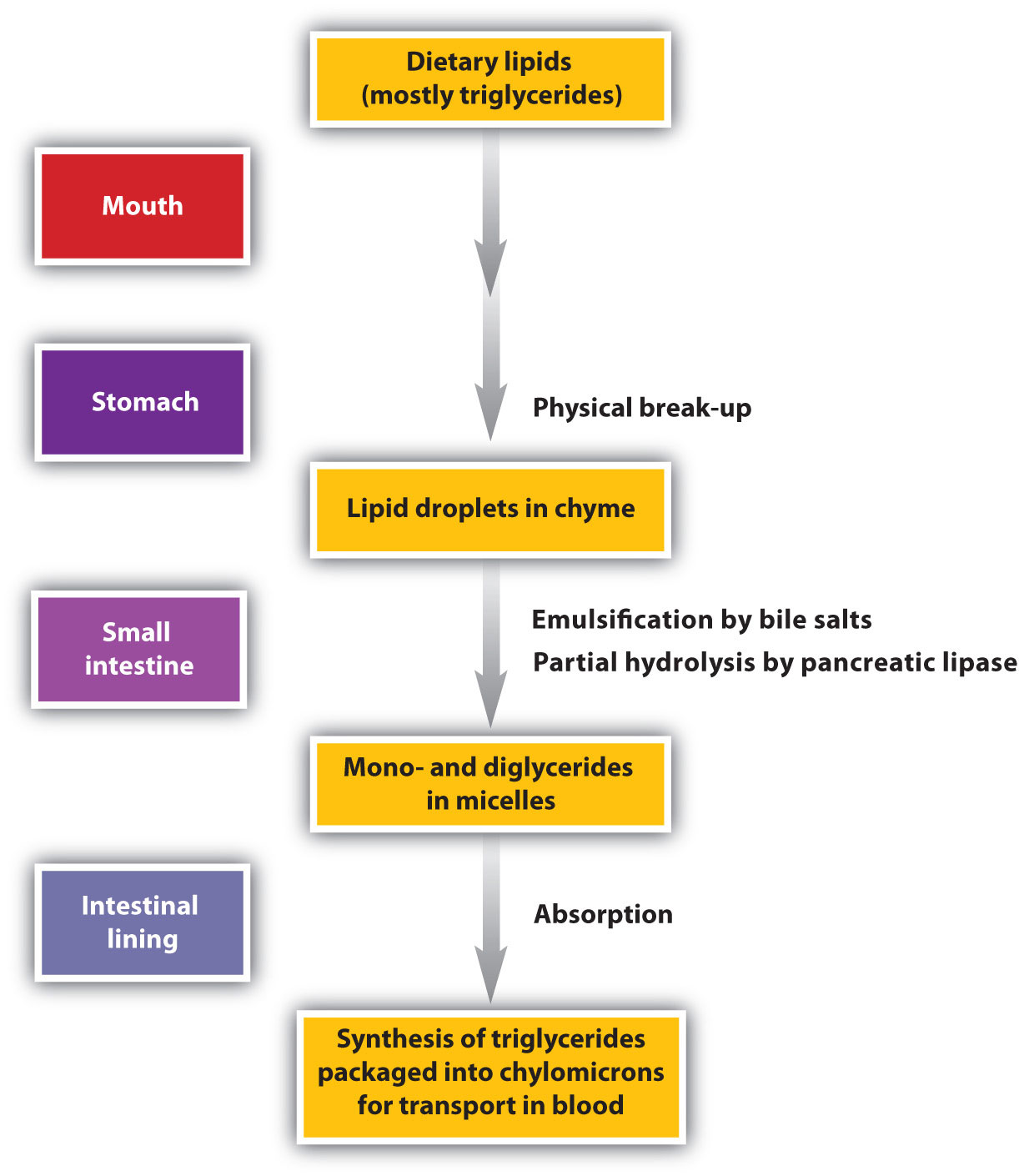
The lipases in pancreatic juice catalyze the digestion of triglycerides first to diglycerides and then to 2‑monoglycerides and fatty acids:

The monoglycerides and fatty acids cross the intestinal lining into the bloodstream, where they are resynthesized into triglycerides and transported as lipoprotein complexes known as chylomicrons. Phospholipids and cholesteryl esters undergo similar hydrolysis in the small intestine, and their component molecules are also absorbed through the intestinal lining.
Fats, Cholesterol, and Human Health
The primary sterol that we consume is cholesterol. The structure of cholesterol is shown below.
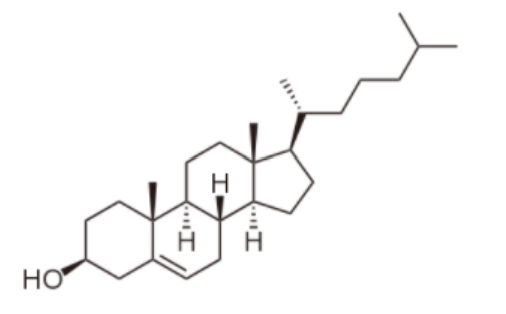
Cholesterol is frequently found in foods as a cholesterol ester, meaning that there is a fatty acid attached to it. The structure of a cholesterol ester is shown below. All sterols have a similar structure to cholesterol. Cholesterol is only found in foods of animal origin. If consumers were more knowledgeable, intentionally misleading practices, such as labeling a banana “cholesterol free”, would not be as widespread as they currently are today.
Function
Although cholesterol has acquired the status of a nutrition "villain", it is a vital component of cell membranes and is used to produce vitamin D, hormones, and bile acids. You can see the similarity between the structures of vitamin D and estradiol, one of the forms of estrogen shown below.

Figure \(\PageIndex{3}\) Structures of vitamin D3 and estradiol (a form of estrogen)2,3
We do not need to consume any cholesterol from our diets (not essential) because our bodies have the ability to synthesize the required amounts. The figure below gives you an idea of the cholesterol content of a variety of foods.
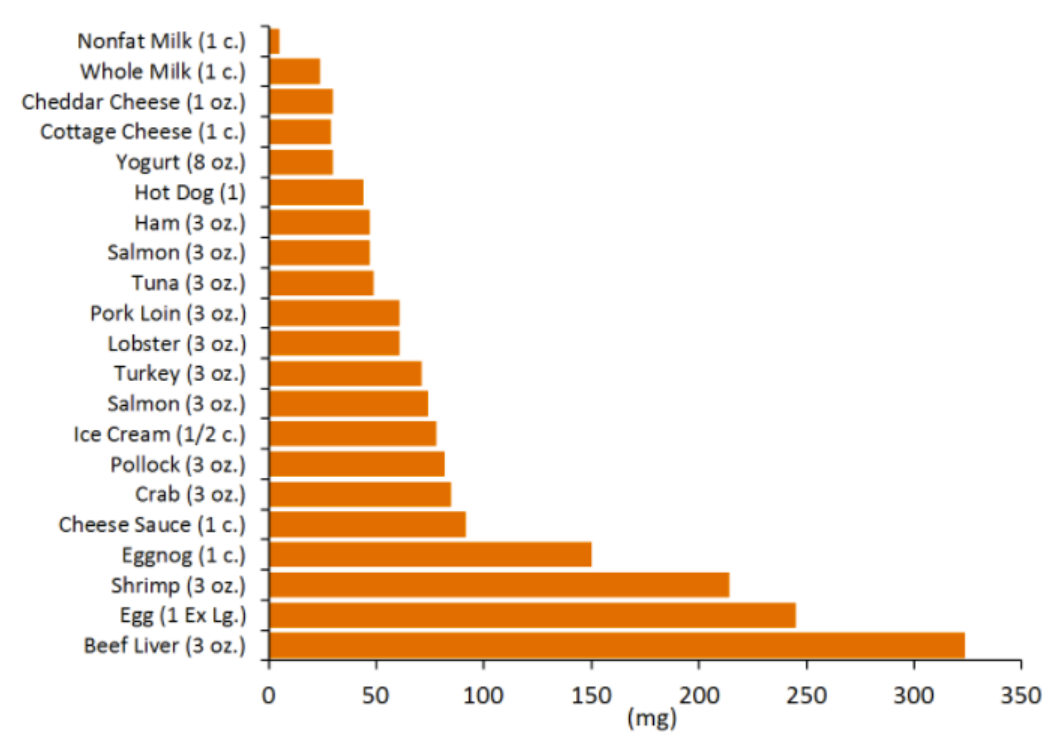
There is neither bad nor good cholesterol, despite these descriptions being commonly used for LDL and HDL, respectively. Cholesterol is cholesterol. HDL and LDL contain cholesterol but are actually lipoproteins that will be described below.
Too much cholesterol in the blood can combine with other substances to form plaque. Plaque sticks to the walls of the arteries. This buildup of plaque is known as atherosclerosis. It can lead to coronary artery disease, wherein the coronary arteries become narrow or even blocked.
The most common cause of high cholesterol is an unhealthy lifestyle. This can include:
- Unhealthy eating habits, such as eating lots of bad fats. One type, saturated fat, is found in some meats, dairy products, chocolate, baked goods, and deep-fried and processed foods. Another type, trans fat, is in some fried and processed foods. Eating these fats can raise your LDL (bad) cholesterol.
- Lack of physical activity, with lots of sitting and little exercise. This lowers your HDL (good) cholesterol.
- Smoking, which lowers HDL cholesterol, especially in women. It also raises your LDL cholesterol.
Genetics may also cause people to have high cholesterol. For example, familial hypercholesterolemia (FH) is an inherited form of high cholesterol. Other medical conditions and certain medicines may also cause high cholesterol.
HDL, LDL, and VLDL
Lipoproteins, as the name suggests, are complexes of lipids and protein. The proteins within a lipoprotein are called apolipoproteins (aka apoproteins). T
There are a number of lipoproteins in the body. They differ by the apolipoproteins they contain, size (diameter), density, and composition. The table below shows the difference in density and diameter of different lipoproteins. Notice that as diameter decreases, density increases.
| Lipoprotein | Density (g/dL) | Diameter (nm) | Purpose |
|---|---|---|---|
| HDL (high-density lipoproteins) | 1.063-1.21 | 5-12 | It is sometimes called "good" cholesterol because it carries cholesterol from other parts of your body back to your liver. Your liver then removes the cholesterol from your body. |
| LDL (low-density lipoproteins) | 1.019-1.063 | 18-25 | It is sometimes called "bad" cholesterol because a high LDL level leads to the buildup of plaque in your arteries. |
| VLDL (very low-density lipoproteins) | 0.95-1.006 | 30-80 | Some people also call VLDL a "bad" cholesterol because it too contributes to the buildup of plaque in your arteries. But VLDL and LDL are different; VLDL mainly carries triglycerides and LDL mainly carries cholesterol. |
This inverse relationship is a result of the larger lipoproteins being composed of a higher percentage of triglyceride and a lower percentage of protein as shown below.
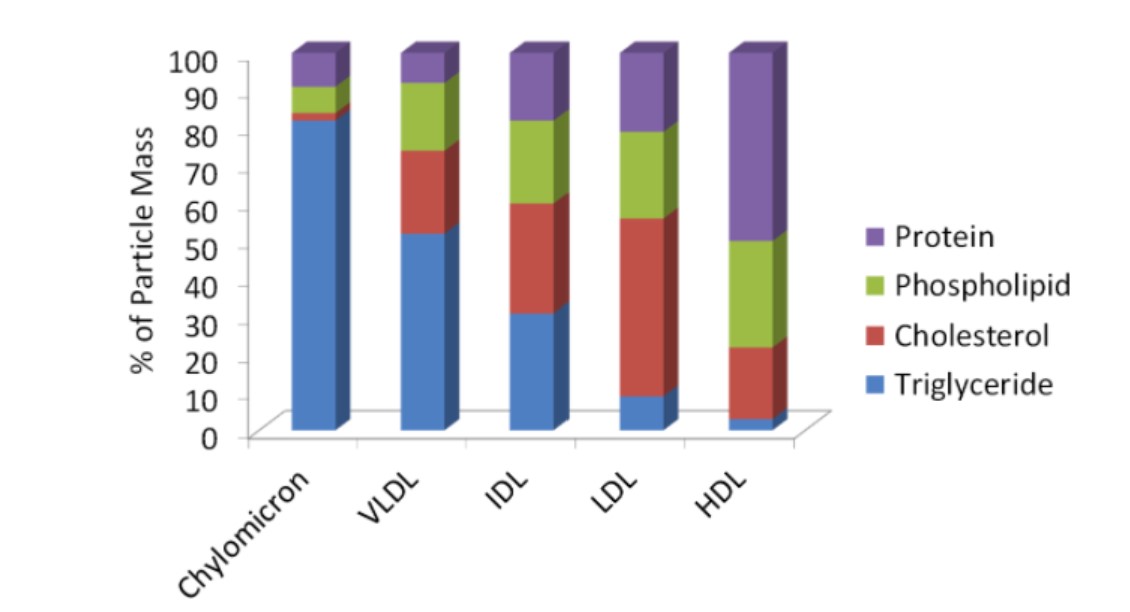
Protein is more dense than triglyceride (why muscle weighs more than fat), thus the higher protein/lower triglyceride composition, the higher the density of the lipoprotein. Many of the lipoproteins are named based on their densities (i.e. very low-density lipoproteins).
You are probably familiar with HDL and LDL being referred to as "good cholesterol" and "bad cholesterol," respectively. This is an oversimplification to help the public interpret their blood lipid values, because cholesterol is cholesterol; it's not good or bad. LDL and HDL are lipoproteins, and as a result you can't consume good or bad cholesterol, you consume cholesterol. A more appropriate descriptor for these lipoproteins would be HDL "good cholesterol transporter" and LDL "bad cholesterol transporter."
What's so bad about LDL? LDL enters the endothelium where it is oxidized. This oxidized LDL is engulfed by white blood cells (macrophages), leading to the formation of what are known as foam cells. The foam cells eventually accumulate so much LDL that they die and accumulate, forming a fatty streak. From there the fatty streak, which is the beginning stages of a lesion, can continue to grow until it blocks the artery. This can result in a myocardial infarction (heart attack) or a stroke. HDL is good in that it scavenges cholesterol from other lipoproteins or cells and returns it to the liver. The figure below shows the formation of the fatty streak and how this can progress to a point where it greatly alters blood flow.
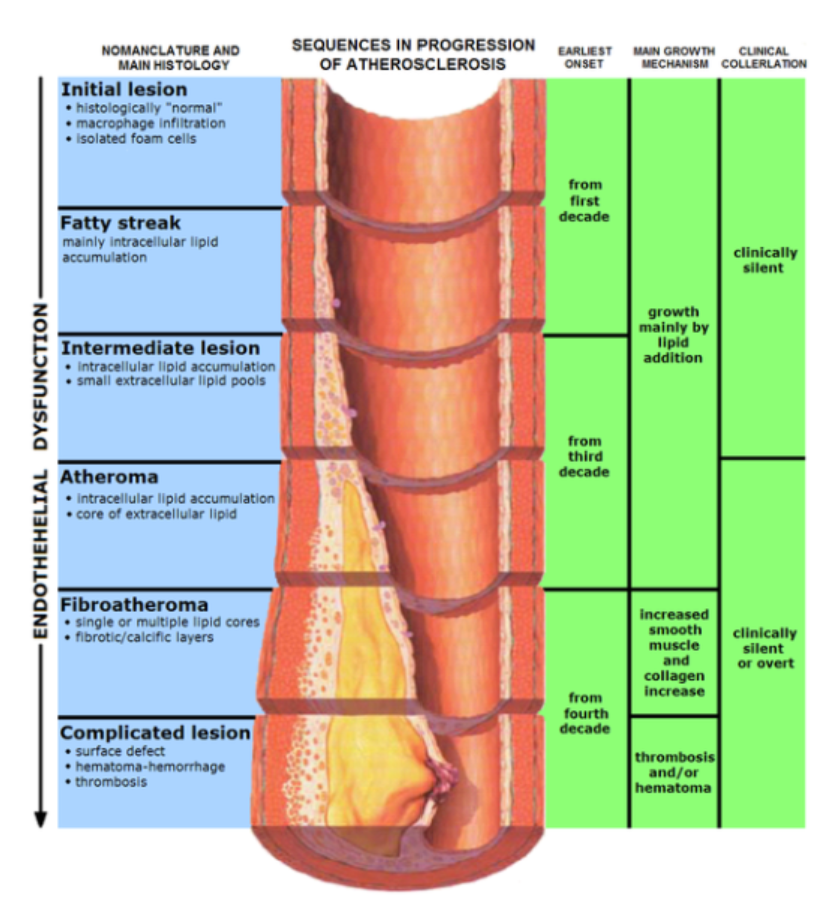
Web links
The video below does an excellent job of illustrating this process. However, there are two caveats to point out. First, it incorrectly refers to cholesterol (LDL-C etc.), and second, it is clearly made by a drug company, so keep these factors in mind. The link below is the American Heart Association’s simple animation of how atherosclerosis develops.
Despite what you learned above about HDL, a recent study questions its importance in preventing cardiovascular disease. It found that people who have genetic variations that lead to higher HDL levels were not at decreased risk of developing cardiovascular disease. You can read more about this interesting finding in the first link below. In addition, another recent study is questioning whether saturated fat is associated with an increased risk of cardiovascular disease.
Doubt Cast on the ‘Good’ in ‘Good Cholesterol’
Study Questions Fat and Heart Disease Link
The following video gives a general overview of macronutrient digestion, uptake, and absorption.
Saturated Fats, Unsaturated Fats, Essential Fatty Acids, and Trans Fats
Chain Length of Fatty Acids
Fatty acids have different chain lengths, typically between four and 24 carbons, and most contain an even number of carbon atoms. When the carbon chain length is shorter, the melting point of the fatty acid becomes lower (such as fats found in dairy products) and the fatty acid becomes more liquid. Longer chain lengths tend to result in more solid fats, although melting point is also influenced by the degree of saturation.
Degrees of Saturation of Fatty Acids
Fatty acid chains are composed primarily of carbon and hydrogen atoms that are bonded to each other. The term “saturation” refers to whether the carbon atom in a fatty acid chain is filled (or “saturated”) to capacity with hydrogen atoms. In a saturated fatty acid, each carbon is bonded to two hydrogen atoms, with single bonds between the carbons.
Alternatively, fatty acids can have points where hydrogen atoms are missing, because there is a double bond between carbons (C=C). This is referred to as a point of unsaturation, because the carbon is only bonded to one hydrogen atom instead of two. Unsaturated fatty acids have one or more points of unsaturation, or double bonds between the carbons. A monounsaturated fatty acid is a fatty acid with one double bond, and a polyunsaturated fatty acid is a fatty acid with two or more double bonds.
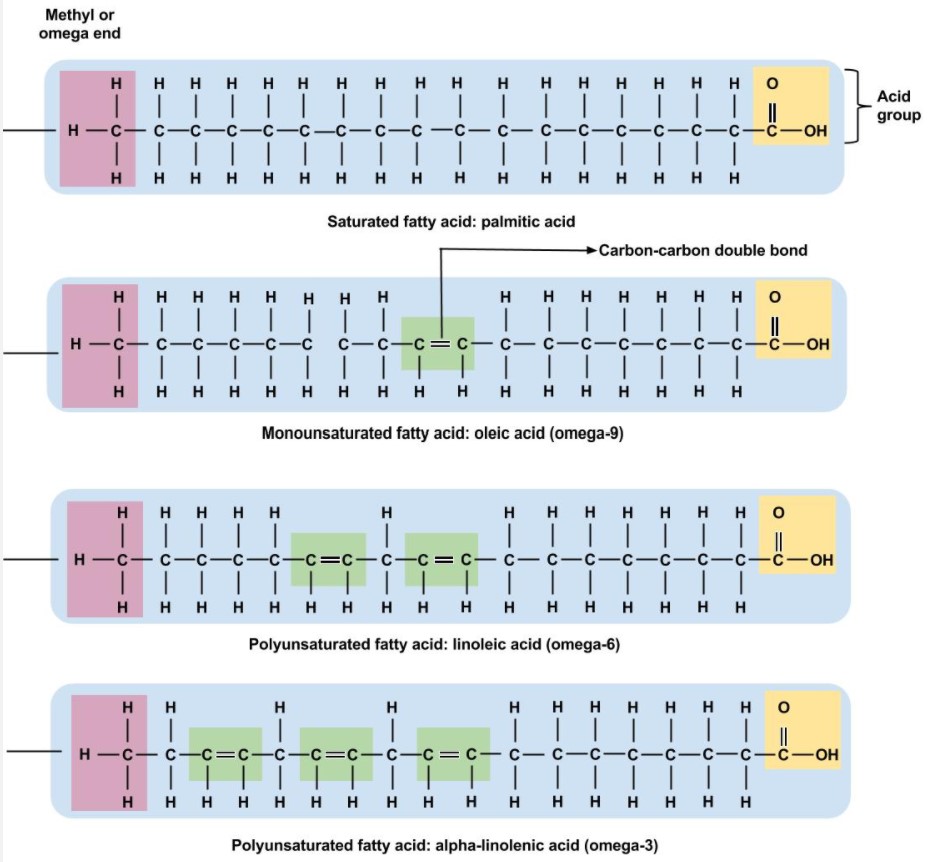
Triglycerides in food contain a mixture of saturated, monounsaturated, and polyunsaturated fatty acids, but some foods are better sources of these types of fatty acids than others (Figure 5.13). For example, coconut oil is very high in saturated fat, but it still contains some monounsaturated and polyunsaturated fatty acids. Peanut oil is often thought of as a good source of monounsaturated fat, because that is the predominant fatty acid in the oil, but peanut oil also contains a fair amount of polyunsaturated fatty acids and even some saturated fatty acids.
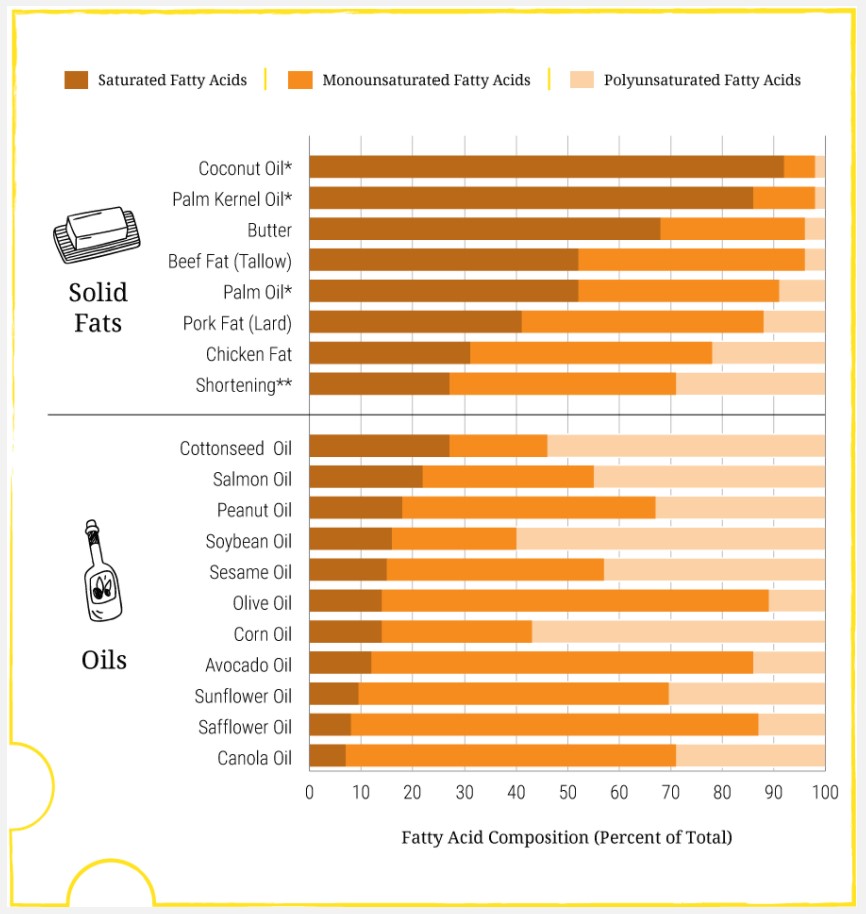
Saturated Fatty Acids
Fat sources with a high percentage of saturated fatty acids tend to be solid at room temperature. This is because the lack of double bonds in the carbon chains of saturated fatty acids makes them very straight, so they pack together well (like a box of toothpicks). Fats that have mostly saturated fatty acids, like butter and coconut oil, are solid at room temperature, as are the visible fat layers in a strip of bacon or a cut of beef. Consuming a diet high in saturated fats is associated with an increased risk of heart disease, because such a diet increases blood cholesterol, specifically the LDL (“bad”) cholesterol level. (More on this later.) Food sources of predominately saturated fatty acids include most animal fats (with the exception of poultry and eggs, which contain more unsaturated fatty acids), dairy products, tropical oils (like coconut and palm oil), cocoa butter, and partially or fully hydrogenated oils.

Unsaturated Fatty Acids
Fat sources rich in unsaturated fatty acids tend to be liquid at room temperature, because the C=C double bonds create bends in the carbon chain, making it harder for fatty acids to pack together tightly. Consuming a diet rich in mono- and polyunsaturated fats is associated with a lower LDL cholesterol level and a lower risk of heart disease.
Food sources of predominately monounsaturated fats include nuts and seeds like almonds, pecans, cashews, and peanuts; plant oils like canola, olive, and peanut oils; and avocados. The fat in poultry and eggs is predominantly unsaturated and contains more monounsaturated than polyunsaturated fatty acids.

Food sources of predominately polyunsaturated fats include plant oils (soybean, corn); fish; flaxseed; and some nuts like walnuts and pecans.

Omega-3, Omega-6, and Essential Fatty Acids
In addition to the length of the carbon chain and the number of double bonds, unsaturated fatty acids are also classified by the position of the first double bond relative to the methyl (-CH3) or “omega” end of the carbon chain (the end furthest from the glycerol backbone in a triglyceride). Fatty acids with the first double bond at the third carbon from the omega end are called omega-3 fatty acids. Those with the first double bond at the sixth carbon from the omega end are called omega-6 fatty acids. (There are also omega-9 fatty acids.)

Fatty acids are vital for the normal operation of all body systems, but the body is capable of synthesizing most of the fatty acids it needs. However, there are two fatty acids that the body cannot synthesize: linoleic acid (an omega-6) and alpha-linolenic acid (ALA, an omega-3). These are called essential fatty acids because they must be consumed in the diet. Other fatty acids are called nonessential fatty acids, but that doesn’t mean they’re unimportant; the classification is based solely on the ability of the body to synthesize the fatty acid. Excellent food sources of linoleic fatty acid include plant oils such as corn oil and soybean oil, often found in salad dressings and margarine. Rich food sources of alpha-linolenic acid (ALA) include nuts, flaxseed, whole grains, legumes, and dark green leafy vegetables.
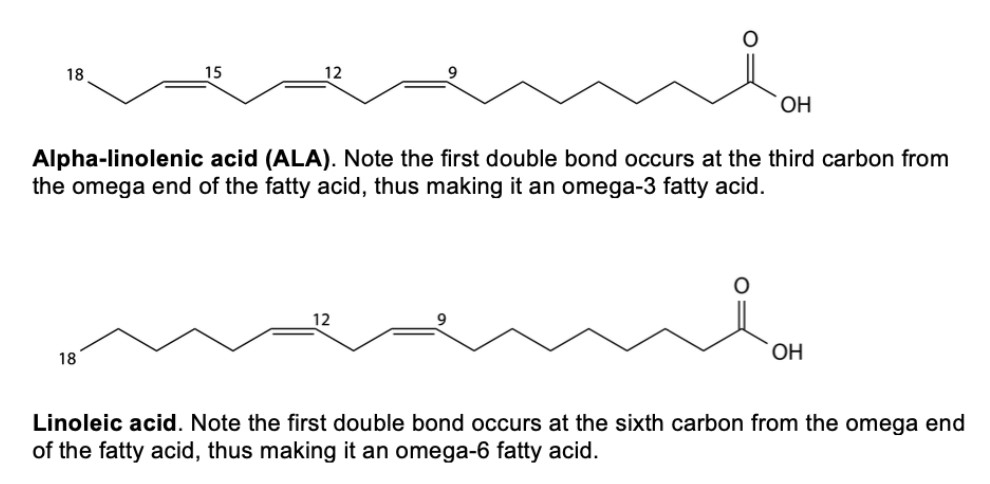
Most Americans easily consume enough linoleic acid and other omega-6 fatty acids, because corn and soybean oil are common ingredients in our food supply. However, sources of ALA and other omega-3 fatty acids are less common in the American diet, and many people could benefit from incorporating more sources of these into their diet. As an added benefit, whole foods rich in ALA come packaged with other healthful nutrients, like fiber, protein, vitamins, minerals, and phytochemicals.
A true essential fatty acid deficiency is rare in the developed world, but it can occur, usually in people who eat very low-fat diets or have impaired fat absorption. Symptoms include dry and scaly skin, poor wound healing, increased vulnerability to infections, and impaired growth in infants and children.1
Omega-3 and omega-6 fatty acids are precursors to a large family of important signaling molecules called eicosanoids (prostaglandins are one type of eicosanoid). Among the many functions of eicosanoids in the body, one of the most important is to regulate inflammation. Without these hormone-like molecules, the body would not be able to heal wounds or fight off infections each time a foreign germ presented itself. In addition to their role in the body’s immune and inflammatory processes, eicosanoids also help to regulate circulation, respiration, and muscle movement.
Eicosanoids derived from omega-6 fatty acids tend to increase blood pressure, blood clotting, immune response, and inflammation. These are necessary functions, but they can be associated with disease when chronically elevated. In contrast, eicosanoids derived from omega-3 fatty acids tend to lower blood pressure, inflammation, and blood clotting, functions that can benefit heart health. Omega-3 and omega-6 fatty acids compete for the same enzymatic pathways in the formation of different eicosanoids, so increasing omega-3 fatty acids in the diet may have anti-inflammatory effects.
Two additional omega-3 fatty acids with important health benefits are eicosapentaenoic acid (EPA) and docosahexaenoic acid (DHA). These long-chain polyunsaturated fatty acids have been shown to help lower blood triglycerides and blood pressure, reduce inflammation, and prevent blood clot formation. They also promote normal growth and development in infants, especially in the development of the brain and eyes. Both of these important omega-3 fatty acids can be synthesized in the body from ALA, so they are not considered essential fatty acids. However, the rate of conversion of ALA to these omega-3s is limited, so it is beneficial to consume them regularly in the diet. Fish, shellfish, fish oils, seaweed, and algae are all good sources of EPA and DHA. DHA is also found in human breast milk in quantities dependent on the mother’s own intake of DHA sources.
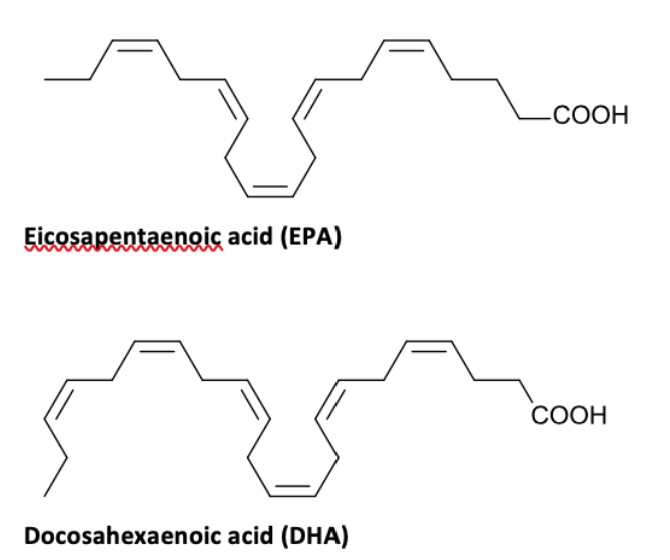
Fish oil and omega-3 supplements are among the most commonly used dietary supplements in the United States. Researchers have hypothesized that these supplements might decrease risk of cardiovascular disease, be helpful for those with rheumatoid arthritis, and improve infant brain development when taken in pregnancy or in infancy. Some studies have found such benefits of the supplements, but others haven’t. One reason for these inconsistent results may be that studies often don’t measure participants’ baseline omega-3 levels and intake from foods, and those already consuming adequate omega-3s are less likely to benefit from a supplement. The Dietary Guidelines for Americans recommends consuming 8 ounces of a variety of seafood each week, and in general, people who meet this recommendation likely consume enough omega-3 fatty acids already (along with the other healthful nutrients found in fish) and are unlikely to see an added benefit of taking a fish oil supplement. Some doctors may recommend that people at risk of cardiovascular disease take a fish oil or omega-3 supplement, especially if they don’t eat fish regularly.2
A Word About Trans Fats
The carbon-carbon double bond in an unsaturated fatty acid chain can result in different shapes depending on whether the fatty acid is in a cis or trans configuration. When the hydrogen atoms are bonded to the same side of the carbon chain, it is called a cis fatty acid. Because the hydrogen atoms are on the same side (and repelling one another), the carbon chain has a bent structure. Naturally-occurring fatty acids usually have a cis configuration.
In a transfatty acid, the hydrogen atoms are bonded on opposite sides of the carbon chain, resulting in a more linear structure. Unlike cis fatty acids, most trans fatty acids are not found naturally in foods, but instead are a result of an industrial process called hydrogenation. Hydrogenation is the process of adding hydrogen to the carbon-carbon double bonds, thus making the fatty acid saturated (or less unsaturated, in the case of partial hydrogenation).
Hydrogenation creates both saturated and trans fatty acids. Trans fatty acids are actually unsaturated fatty acids, but they have the linear shape of saturated fatty acids. (The carbon chains are not bent like naturally-occurring unsaturated fats.) The trans fatty acids formed through partial hydrogenation have an unusual shape, which makes their properties and actions in the body similar to saturated fatty acids.
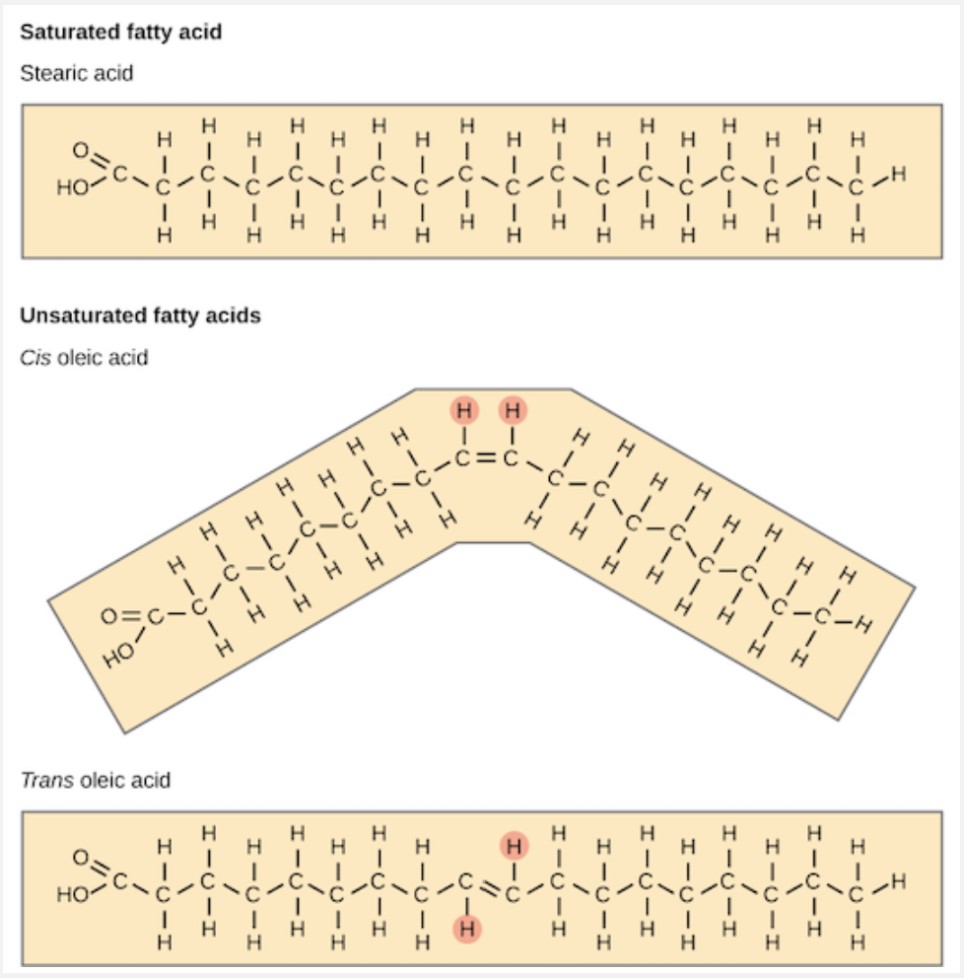
Hydrogenation was developed in order to make oils semi-solid at room temperature, enabling production of spreadable margarine and shortening from inexpensive ingredients like corn oil. Hydrogenation also makes oils more stable and less likely to go rancid, so partially hydrogenated oils were favored by fast food restaurants for frying, and manufacturers of processed baked goods like cookies and chips found they gave their products a longer shelf life. And because trans fats are unsaturated, nutrition scientists and the medical community believed that they were a healthier alternative to saturated fats.
But around the 1990s, evidence that trans fats were not healthy—far worse than saturated fats, in fact—began to accumulate. Like saturated fat, trans fats increase LDL (“bad”) cholesterol, but they also have the effect of decreasing HDL (“good”) cholesterol and of increasing inflammatory processes in the body. Researchers found that consuming trans fats, even at low levels (1 to 3 percent of total energy intake), was associated with an increased risk of coronary heart disease. They estimated that eliminating industrial trans fats from the food supply might prevent as many as 19 percent of heart attacks in the U.S. at the time, coming to 228,000 heart attacks averted.3
In 2006, the U.S. Food and Drug Administration (FDA) began requiring food companies to list trans fat information on the Nutrition Facts panel of food labels to keep consumers informed of their intake of these fats. That prompted the food industry to mostly eliminate partially hydrogenated oils from their products, often substituting palm oil and coconut oil in their place (both of which are high in saturated fat and may promote heart disease). In 2013, the FDA determined that trans fats were no longer considered safe in the food supply, and in 2015, the agency issued a ruling requiring that manufactured trans fats no longer be included in the U.S. food supply. A one-year extension was granted in 2018, and foods produced prior to that date were given time to work through the food supply. The final ruling requires all manufactured trans fats to be eliminated from the U.S. food supply by 2021.4
Summary
- Digestion of lipids by lipases in pancreatic juice occurs primarily in the small intestines. The monoglycerides and fatty acids cross the intestinal lining into the bloodstream, where they are resynthesized into triglycerides and transported as chylomicrons. Phospholipids and cholesteryl esters undergo similar hydrolysis in the small intestine, and their component molecules are also absorbed through the intestinal lining.
- Two lipoproteins (composed of a lipid and a protein) of great interest are HDL "good cholesterol transporter" and LDL "bad cholesterol transporter."
- Trans fats are unhealthy fats that form when vegetable oil hardens in a process called hydrogenation. They can raise LDL cholesterol levels in the blood. They can also lower HDL (good) cholesterol levels. Trans fats are under review for their health effects.
- Saturated fats are also considered as unhealthy fats.
- Studies indicate that the consumption of monounsaturated fats and polyunsaturated fats (specifically those with omega-3 fatty acids) have numerous health benefits.
Contributors and Attributions
- Template:ContribLindshield
- Libretexts: Nutrition Science and Everyday Application (Callahan et.al.)

